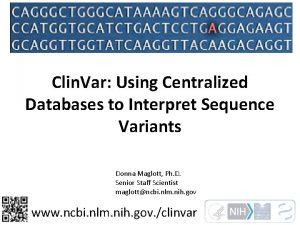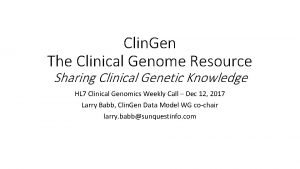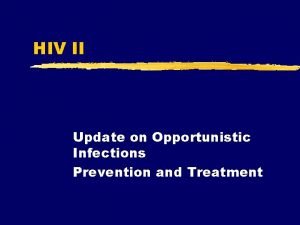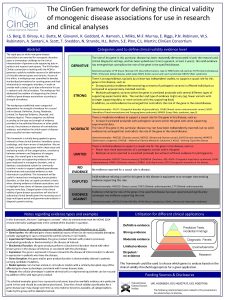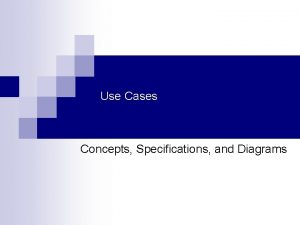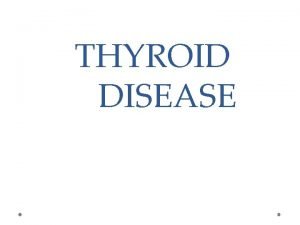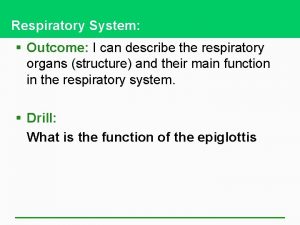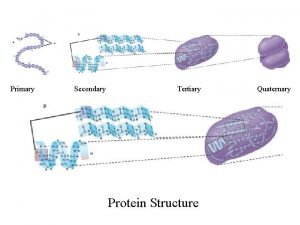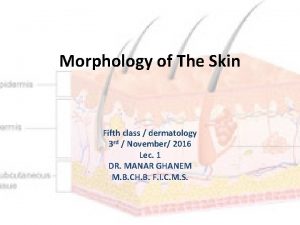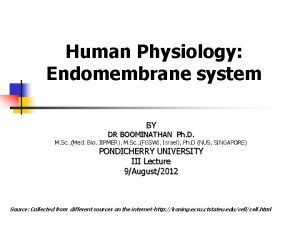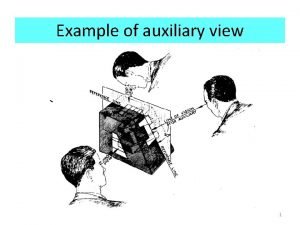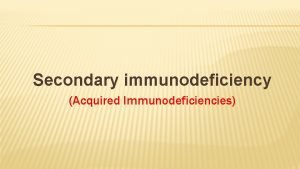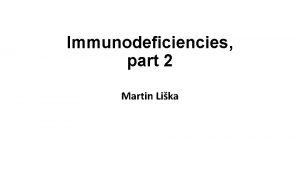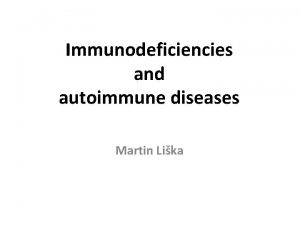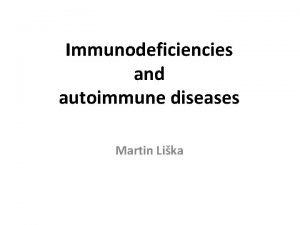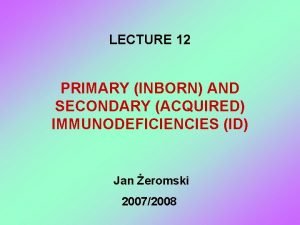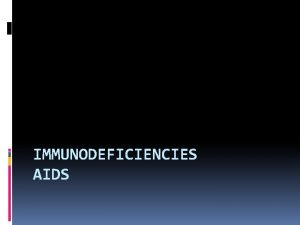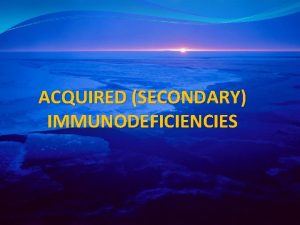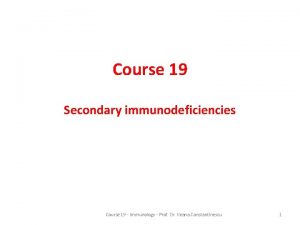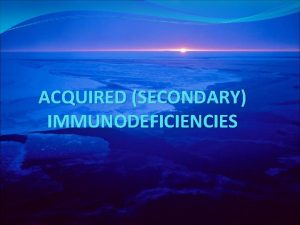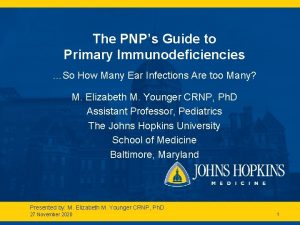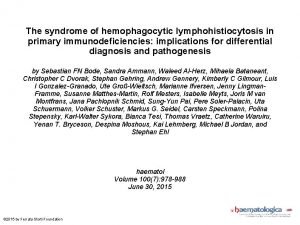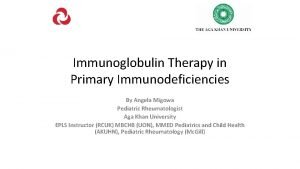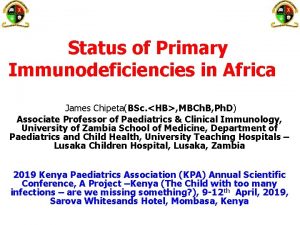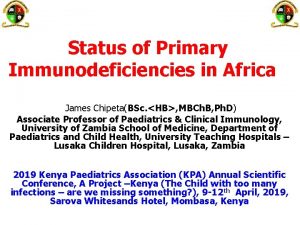Primary and Secondary Immunodeficiencies Ji Litzman Dept Clin



















































- Slides: 51

Primary and Secondary Immunodeficiencies Jiří Litzman Dept. Clin. Immunol. Allergol, Faculty of Medicine, Masaryk University, Brno

Immunopathological states IMMUNODEFICIENCY ALERGY AUTOIMMUNITY

Bubble boy - David Phillip Vetter (1971 – 1984)

HIV and AIDS in the Czech Republic

Imunodeficiency states • Primary • Caused by defined genetic defect • Usually rare, but severe (exception: Ig. A deficiency) • Secondary • Consequence of some other disease, treatment, environmental factors… • Usually frequent, but usually clinically mild

Causes of secondary immunodeficiency • Metabolic - uremia, diabetes, malnutrition • Iatrogenic – cytostatics, immunosuppressive treatment • Malignat tumors • Viral infections - HIV, CMV, measles, infectious mononucleosis • Splenectomy • Stress • Injuries, operations, general anestesia

Complications of immunodeficiency • Tendency to infectious complications, mainly serious infectious complications. • Infections may be caused by usual or opportunistic pathogens. • The response to antibiotic treatment is insufficient. • In primary immune deficiencies we frequently observe other complications caused by dysregulation of the immune system - autoimmunity, allergic diseases, inflammatory diseases. • The incidence of malignancies is increased. This increase is extreme in primary immune deficiencies associated with increased chromosomal instability.

Typical infectious complications of immunodeficiencies • Antibody deficiencies: encapsulated bacteria • Complement system disturbances: meningococcal infections, other encapsulated bacteria • T-lymphocyte deficiencies: herpesviral infections (the most important is cytomegalovirus), Pneumocystis jiroveci, mycobacterial infections, deep fungal infections • Phagocytic disorders: fungal infections, several bacterial infections.

Frequency of immunodeficiency diseases • Severe combine immunodeficiency ( SCID) - 1: 50 000 newborns (Czech Republic, much higher in countries with high degree of consanguinity) • Common variable immunodeficiency - prevalence 1: 20 000 • Di George syndrome - 1: 4 000 newborns • HIV - 36. 7 millions infected 2015 (estimation) • Malnutrition: 22, 9 % of population ( UNICEF 2016)

Types of immunodeficiencies in dependence of the affected component of the immune system • Antibody production deficiencies • Abnormalities of number or function of T-lymphocytes • Complement system disturbances • Abnormalities in number or function of myeloid cells • Combined immunodeficiencies

Biological functions of immunoglobulin molecules • Activation of complement system (Ig. G, Ig. M) • Opsonization (Ig. G) • Neutralization of antigens (Ig. G, Ig. A, Ig. M) • Adherence interference (Ig. A, Ig. G) • Antibody dependent cellular cytotoxicity (ADCC) • Agglutination, precipitation (Ig. G, Ig. M) • Mast cells degranulation (Ig. E) • Transport through placenta (Ig. G) • Imunoregulation (mainly Ig. G)

Antibody Deficiencies • Ig. G deficiency is clinically the most significant. Disorders of Ig. A and Ig. M disturbed production do not lead to significant clinical complications. • The most commonly affected system is the respiratory tract. Typical complications are bronchitis, pneumonia, sinusitis, otitis in adulthood. Recurrent infections lead to bronchiectasis development. • Encapsulated bacteria - Haemophilus sp. , Pneumococcus, Staphylococcus, or others are the predominant pathogens. • The frequency of viral infections is not significantly increased. An exception is enteroviral encephalitis in patients with severe antibody production disorders.

Diagnosis of Antibody Deficiency • Serum levels of Ig. G, Ig. A, Ig. M • Enumeration of B-lymphocytes (in many diseases may be normal!). • Investigation of antibody levels against tetanus toxoid, pneumococcal polysaccharide (PCP). • Monitoring of specific antibody response after vaccination with protein (tetanus anatoxin) and polysaccharide (eg. Pnemococcal non-conjugated vaccine, Salmonella typhi vaccine) antigens. Examination before vaccination and one month after the vaccination.

The most important primary antibody immunodeficiencies • X-linked agammaglobulinaemia: only boys affected, manifestations after 6 months of age. Caused by Bruton tyrosine kinase mutation • Common variable immunodeficiency (CVID). Both sexes are affected. The beginning of clinical manifestation at any age. Autoimmune (ITP, pernicious anemia) and inflammatory (granulomatous) complications are common. The disease may be caused by mutations of many different genes. • Selective Ig. A deficiency - prevalence approximately 1: 500. Often clinically silent. Cave: anti-Ig. A antibodies when Ig. D administered in blood derivatives. Possibility of progression to CVID.

Secomndary hypogammaglobulinemia • Disturbed antibody production • • Chronic lymphatic leukemia (CLL) Lymphomas Myeloma Drug-induced hypogammaglobulinaemia • • Nephrotic syndrome Exductive enteropathy - IBD, celiac disease, intestinal lymphangiectasis Severe atopic eczema Peritoneal dialysis • Increased immunoglobulin losses

Hypogamaglobulinaemia in Patients with Chronic Lymphatic Leukaemia • Hypogammaglobulinaemia is present in approximately 8% of patients in the time of diagnosis. • Present in approximately 70% of the patients seven years after diagnosis. • It is not affected by ongoing oncology treatment. • Many studies have shown the relationship between the number of infections and the level of immunoglobulins. • Prophylactic antibiotic therapy or substitution immunoglobulin therapy is indicated in patients with clinical manifestation of immunodeficiency.

Immunodeficiency in myeloma • The presence of paraprotein may lead to hypergammaglobulinaemia. • However, the levels of specific antibodies (including antimicrobial) are reduced. • This results in symptomatic humoral immune deficiency - especially frequent and complicated respiratory infections. • Granulocytopenia and T-cell deficiency may contribute to immunodeficiency. • Substitution immunoglobulin therapy is indicated in patients with severe immunodeficiency manifestation.

Hypogamaglobulinamia in Nephrotic Syndrome • A marked decrease in Ig. G levels can be observed, whereas Ig. A and Ig. M levels are minimally altered. • The production of specific postvaccination antibodies is not affected. • Due to the loss character of hypogammaglobulinaemia, immunoglobulin replacement therapy is not used. • Immune deficiency may be due to deficiency of vitamin D deficiency as well. • Patients may suffer from repeated bacterial respiratory or urinary infections, sepsis may develop.

Drug-induced hypogammaglobulinaemia • • • Anti CD 20 monoclonal antbodeis (rituximab) Glucocorticoid treatment Other „classical“ immunosuppressive agents – metotrexate, azathioprine…. Other drugs interfering with B-cell development (Ibrutimib…) Sulfasalazin (rheumatology, gastroenterology) Antiepileptic drugs (Karbamazepin, Fenytoin) Penicilamin (gastroentrology) Kaptopril (antihypertinic drugs) And many others

Neutrophil granulocytes • The most important cells involved in non-specific cellular immunity directed against microbes: • They are the most numerous peripheral blood leukocytes • They have excellent ability to penetrate the affected tissues • They have a number of mechanisms capable of killing bacteria and fungi • They are also significant proinflammatory cytokine producers in the early stages of inflammation.

Clinical Manifestion of Disturbances of Number and Function of Granulocytes. • Granulocytopaenia - Necrotizing inflammation of mucous membranes. The most common are disorder in the oral cavity (gingivitis, tonsillitis), rectum, genitals. Frequently accompanied by fever. • (Secondary) functional disorders of granulocytes - staphylococcal pyoderma, phlegmons. Infections with encapsulated bacteria. • Primary disorders of granulocyte function - tendency to abscess formation, bacterial and fungal infections.

Classification of neutropaenia • Light neutropenia <1500 and> 1000 cells / ml • Moderate neutropenia > 500 and <1000 cells / ml • Severe neutropenia <500 cells / ml • Agranulocytosis is usually defined by a decrease in the number of granulocytes below <200 cells / ml (but there are other definitions!) • Chronic neutropenia - lasts> 3 months.

Secondary neutropaenia • Chemicals (DDT) • Diseases affecting the bone marrow (eg malignancy) • Severe infections • Radiation • Autoimmune Disease (SLE) • Nutritional insufficiency - B-12, folate, • Cytostatic drugs • A number of other drugs

Drug-induced neutropaenia • Idosynkratic – unpredictable, independent of the dose. • The immunological mechanism ( II or IV type hypersensitivity) is the most frequent. • Toxic effect of metabolites in enzymatic disorders. • Can be very severe (type B side effect). • Toxic – predictable for a particular drug, relatively frequent, relatively light (type A side effect).

Secondary neutropaenia • A study from 1996 found that about 70% of cases of acquired agranulocytosis are linked to medications. Drugs that can cause agranulocytosis include: • Anti-thyroid medications, such as carbimazole • Anti-inflammatory medications, such as sulafasalazine, and nonsteroidal antiinflammatory drugs (NSAIDs) • And many others

Primary granulocytopaenia • Kostmann syndrome • Cyclic granulocytopaenia • Many other inborn diseases associated with granulocytopaenia

Kostmann Syndrome • Severe congenital agranulocytosis • Defect of maturation at the level of promyelocytes and myelocytes • <200 neutrophils/ml in peripheral blood • Necrotizing inflammation of the skin and mucous membranes • Genetic cause: most commonly mutation of the leukocyte elastase gene

Cyclic granulocytopaenia • Necrotizing and ulcerative inflammation of mucous membranes and skin accompanied by fever. • Recurrent attacks after approximately 3 weeks. • The mutation of the granulocyte elastase gene is a frequent cause.

Primary defects of granulocyte function • Chronic granulomatous disease - impaired formation of reactive oxygen metabolites, mutation of NADPH oxidase components. Formation of abscesses (liver, periproctal and other parts of the body), granuloma formation. • Leukocyte adhesion deficiency (LAD) syndrome - CD 11 / CD 18 adhesion molecule expression disorder. Disturbance of granulocyte adhesion to endothelium. Consequent phlegmons with only serous (not purulent) content, but there is a marked granulocytosis in the blood. Disturbed umbilical separation and healing.

T-lymfocytes - function • Helper function (especially CD 4 + lymphocytes) • Activation of macrophages (Th 1) • Assistance in making antibodies (Th 2) • Pro-inflammatory effect (Th 17) • Control functions (CD 4 +) • T-reg lymphocytes • Auxiliary and regulatory functions are primarily mediated by cytokine production. • Cytotoxic effect (CD 8 + lymphocytes)

T lymfocyte central regulator of the immune response Ag Ag APC Antigen-presenting cell Ag Th B cell Cytokines Tc cell Granulocyte Macrophage Cytokines NK NK cell

Abnormalities in Function and Number of T-lymphocytes • Increased susceptibility to viral infections, especially herpesvirus infections. The most important is the susceptibility to CMV complications. Activation of EBV can lead to EBV lymphoproliferative syndrome. • Mycobacterial infections • Severe disorders: opportunistic pathogens: Pneumocystis jiroveci, deep mycosis, cerebral toxoplasmosis (typical for HIV+ patients).

Complement system Deficiencies • C 1 -C 4: frequent development of systemic immunocomplex diseases (SLE-like), susceptibility to pyogenic infections. • C 3 -C 9: susceptibility to pyogenic infections. C 9 deficiency is characterized by repeated meningococcal meningitis. • C 1 INH: hereditary angioedema.

Imunodeficiency after Splenectomy or in Hyposplenism • Pathogenesis: decrease of antibodies against polysaccharide antigens. • Phagocytosis is disturbed because of tuftsin deficiency. • Failure of phagocytosis of polysaccharide antigens by splenic macrophages. • Presence of Howell-Jolly bodies in erythrocytes (residuals of erythrocyte nuclei) san be observed in patients with splenic dysfunction. However the sensitivity and specificity of the test are not sufficient.

Immunodeficiency after splenectomy • Caused by a phagocytosis disorder in the spleen and periphery (tuftsin deficiency), decreased production of antipolysaccharide antibodies. • The most serious complication is the development of hyperacute pneumococcal sepsis. • Prevention: pneumococcal vaccination, Haemophilus influenzae B and meningococcal disease, prophylactic PNC administration.

OPSI syndrom (overwhelming postsplenectomyinfection) • Almost exclusively in splenectomized patients • Hyperacute sepsis, most commonly caused by pneumococcus, or other encapsulated microbes. • It occurs in 3 -5% of patients after splenectomy. • Described also in adequately vaccinated patients. • The risk is lifelong, the largest being in the first 5 years after splenectomy. • Letality 50 -80%.

Hyposlenismus • Systemic Diseases • Amyloidosis • Coelic disease • Sarcoidosis • Long-term parenteral nutrition • AIDS • Age under 2 years

Imunodeficiency after trauma or after burns • Associated with the activation of the immune system and the formation of pro-inflammatory cytokines (IL-1, TNF-alpha) and subsequent activation of monocytomacrophage cells with the development of systemic inflammatory response (SIRS) and a subsequent compensatory anti-inflammatory reaction (CARS).

Immunodeficiency in pregnancy • Th 1 cell suppression and increased activity of Treg lymphocytes • Alteration of NK cell function, dendritic, decreased HLA-antigen expression. . . • Increased occurrence of bacterial and viral infections • Increased incidence of infections also involves anatomical changes during pregnancy (uroinfections)

Imunodeficiency caused by stress • Acute stress: increased frequency of viral infections, particularly exacerbations of herpesvirus infections or respiratory infections. • Chronic stress is also associated with increased susceptibility to malignancies. • Changes in the number and function of NK cells and T-lymphocytes were observed.

Imunodefiency caused by infections • Viruses: HIV, but also measles, herpesviruses • Bacteria - less important, especially bacteria producing superantigens (Staphylococci, streptococci)

Immunodeficiency after biological treatment • Monoclonal antibodies targeting B-lymphocytes (eg Rituximab) - the risk of unclear hypogammaglobulinaemia. Granulocytopaenia may also develop. In severe causes, substitution immunoglobulin therapy should be initiated. • Monoclonal antibodies interfering with granulocytic migration (eg natalizumab - alpha-4 -integrin antibodies) - the risk of developing progressive multifocal panencephalitis (JC virosis). • Anticytokine therapy (eg anti-TNF alfa - infliximab, adalimumab) - risk of TB reactivation, bacterial sepsis, invasive fungal infections. These complications are rare in IL-1 biologic therapy.

Immunity in seniors • Complex immune deficiency and dysregulation in the elderly is referred to as immunosenescence. • Primary immune response is compromised, while secondary immune responses are generally not affected. • The decrease in the number of lymphocytes, especially CD 4 +, immunoglobulin levels are frequently increased. • In general, reduced immune reactivity results in mild clinical symptoms of infections but also in relative secondary immunodeficiency. • Immune dysregulation is manifested by frequent occurrence of autoantibodies and paraproteins, but these do not usually lead to clinical illness.

Immunodeficiency in chronic renal failure • Pathogenesis: • • Phagocytosis disorders and cellular immunity due to vitamin D 3 deficiency Effects of uremic factors Phagocytosis disorder due to activation on dialysis membranes Secondary antibody immunodeficiency due to T-cell deficiency • Clinical picture: increased incidence of TB, staphylococcal infections, chronic HBs. Ag

Immunodeficiency in diabetes • Complex impairment of immune functions, the most significantly disturbed is phagocytosis (chemotaxis, killing ability), due to impaired glucose metabolism in granulocytes. • T-lymphocyte abnormalities can also be detected. • Microangipathy leads to disturbed blood circulation in the tissues. This results is insufficient penetration of granulocytes into the site of inflammation. • Clinical consequences are pyoderma, poor wound healing, phlegmons, peripheral necrosis, fungal skin infections.

Immunodeficiency in chronic liver failure • Low levels of complement system components, impaired function and number of neutrophils due to hypersplenism. • In patients with a portal shunt, the filtrating function of the Kupfer cells is missing, leading to the fact that particles (including bacteria) or toxins ( including endotoxin) from the portal vein enters the systemic circulation. • Leads to phlegmons, pyoderma, pulmonary complications • Severe hepatic failure - tendency to sepsis and bacterial peritonitis.

Immundeficincy caused by malnutrition • Protein-calorie malnutrition, hypovitaminosis, lack of trace elements can be used. • The specific immune system affects how much of the food is inadequate. • It is estimated that severe malnutrition exacerbates the increase in mortality of pneumonia 10 x, gastroenteritis 30 x. • The cause may be malnutrition, but also anoraxia nervosa, alcoholism, digestive tract diseases. • Clinically, patients have an increased incidence of infections, including parasitic and mycobacterial infections.

Non-immunodeficiency diseases that can manifest like immunodeficiencies • Allergic diseases of the respiratory tract • Adenoids • Gastroesophageal reflux • Anatomical abnormalities • Cystic fibrosis • Ciliary dyskinesis

Gentic abnormalities of the immune system that usually do not lead to immunodeficiency symptoms • Selective Ig. A deficiency (prevalence of about 1: 500) • Deficiency of mannan-binding lectin (MBL – activator of the third complement pathway) homozygous deficiency 5%, 25% hetrozygous deficiency. • Deficiency CCR 5 Δ 32 (in Europe about 1% of homozygos, 5 -10% of heterozygotes) - perhaps aggravating complications in flavivirus infections (tick encephalitis), protect against HIV, perhaps plague. • However, we can also meet with patients with marked hypogammaglobulinaemia without symptoms of immunodeficiency.

Therapy of primary immunodefciemncies • The most severe conditions (SCID, LAD syndrome, Wiskott. Aldrich syndrome) - hematopoietic cell transplantation. • Antibody immunodeficiency: substitution immunoglobulin therapy + antibiotic prophylaxis if necessary. • In most other cases, only antibiotic prophylaxis is possible. • Vaccination with live vaccines should always be avoided. • In patients with T-cell and combined immunodeficiency, only irradiated blood derivatives may be administered - the risk of transfusion-induced GVHR.

Gene therapy of primary immunodeficiencies • The principle is the transduction of the missing gene into the target cells (in primary immunodeficiencies, preferably CD 34 +) cells. • Retroviral vectors, in which the gag, env, pol genes have been replaced with the desired gene, are used. LTR sequences allow the insertion of DNA into the genome of the cell. • Also reverse transcriptase is included in the vector allowing transcription from RNA to c-DNA. • Experimentally used in some types of SCID (if not a suitable donor of hematopoietic cells). • Anecdotal cases of chronic granulomatous disease, Wiskott. Aldrich syndrome.
 Clin var
Clin var Clin gen
Clin gen Research card
Research card Clin chest med
Clin chest med Clin gen
Clin gen Liz welch mississippi
Liz welch mississippi Florida dept of agriculture and consumer services
Florida dept of agriculture and consumer services Florida dept of agriculture and consumer services
Florida dept of agriculture and consumer services Department of agriculture consumer services
Department of agriculture consumer services Primary and secondary effects of a tectonic hazard
Primary and secondary effects of a tectonic hazard Secondary stakeholders
Secondary stakeholders Primary pollutants and secondary pollutants
Primary pollutants and secondary pollutants Primary volcanic hazards
Primary volcanic hazards Use case primary and secondary actors
Use case primary and secondary actors Pengertian include dan extend
Pengertian include dan extend Static efficiency
Static efficiency Postpartum thyroiditis
Postpartum thyroiditis Primary and secondary retroperitoneal organs
Primary and secondary retroperitoneal organs Difference between primary and secondary succesion
Difference between primary and secondary succesion Tertiary alcohol oxidation
Tertiary alcohol oxidation Project background example
Project background example 5 agents of socialization
5 agents of socialization Primary and secondary deviance
Primary and secondary deviance Primary and secondary bronchi
Primary and secondary bronchi Differentiate primary and secondary tillage
Differentiate primary and secondary tillage Primary secondary tertiary sources
Primary secondary tertiary sources Secondary to tertiary structure
Secondary to tertiary structure Autobiography is a primary source
Autobiography is a primary source Secondary light source
Secondary light source Positive reinforcement psychology definition
Positive reinforcement psychology definition Symport antiport uniport
Symport antiport uniport Primary needs and secondary needs
Primary needs and secondary needs Primary and secondary lesions of skin
Primary and secondary lesions of skin Monocots eudicots
Monocots eudicots Active transport
Active transport Primary secondary tertiary health care definition
Primary secondary tertiary health care definition Insight learning
Insight learning What is numerical discrete
What is numerical discrete Primary energy and secondary energy
Primary energy and secondary energy Web
Web Primary target market and secondary target market
Primary target market and secondary target market Gingival bevel definition
Gingival bevel definition Primary energy and secondary energy
Primary energy and secondary energy Primary pollutants
Primary pollutants Primary lysosome vs secondary lysosome
Primary lysosome vs secondary lysosome Primary needs and secondary needs
Primary needs and secondary needs Primary needs and secondary needs
Primary needs and secondary needs Behavior that matches group expectations
Behavior that matches group expectations Primary, secondary and tertiary food processing
Primary, secondary and tertiary food processing Secondary food processing
Secondary food processing What is auxiliary view
What is auxiliary view Diff between primary and secondary battery
Diff between primary and secondary battery
